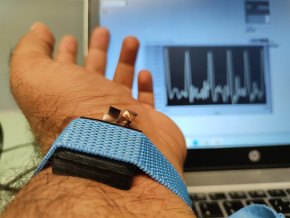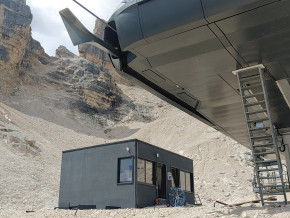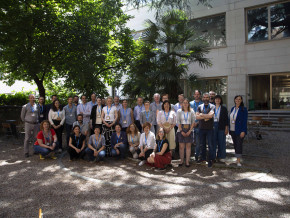First aid from above
Eurac Research and Mountain Rescue South Tyrol test the use of drones for emergency operations in the Bletterbach Gorge
In recent months, research teams from emergency medicine, mountain rescue, drone and electrical engineering have been drawn to the Bletterbach Gorge (South Tyrol) time and again to simulate rescue missions. The interregional research project START, has seen a steady flow of these teams to the gorge, to investigate whether drones can help in the localisation and initial treatment of persons injured in difficult to access terrain.
Eight kilometers long and up to 400 meters deep, the Bletterbach Gorge near Aldein (South Tyrol) is carved into dolomite rock and the homepage of the gorge’s UNESCO World Heritage Site advertises a journey through 40 million years of the earth's history. About 50,000 visitors follow the call every year. Sturdy shoes and a helmet are a prerequisite for exploring the boulders, scree, fallen tree trunks and roots. The path guides you through a narrow gorge with steep rock walls to a wider valley with flatter sediment slopes, but always along the Bletterbach stream, which - depending on precipitation - meanders through the stream bed.
The terrain is remarkable, not only for geologists, nature lovers and tourists. In the course of the interregional research project START, emergency medicine physicians, mountain rescuers, drone pilots and electrical engineers have all been summoned to the unique geological setting. "It is particularly difficult to locate injured people here," explains Michiel van Veelen, emergency physician at Eurac Research: "The terrain is difficult to access - and in addition, cell phones have no reception here." Perfect conditions, then, to test the use of drones in locating and providing first aid to injured people in difficult to access terrain. From fall 2020 to early summer 2021, the START team simulated 24 missions at different locations within the gorge - sometimes in the scree field at the end of the gorge, sometimes at the foot of a steep slope at the entrance to the gorge. These are the locations where, according to accident reports from the South Tyrolean Mountain Rescue Service, accidents - shoulder lesions, broken bones, lacerations - have actually occurred in the past 10 years.
All rescue missions begin at the Geopark Bletterbach visitor centre, where START has set up its research tent. Here, against a background hum, drone batteries are charged, data is fed into computers, the teams of the South Tyrol Mountain Rescue Service are briefed, radios are handed out and everyone involved is wired up - from the drone pilot to the mountain rescuers to the simulated victim. During the missions, the vital functions of the entire crew are recorded: heart and breathing rate, skin temperature and ECG curve. "The data provides us with information about the stress to which everyone is exposed," explains Eurac Research emergency medicine physician Giacomo Strapazzon, "We want to know if drone-assisted rescue operations give those involved a greater sense of security, both in mental and physical terms." For the psychological evaluation, the mountain rescuers have to fill out a questionnaire before and after the mission is completed.
The emergency call arrives via radio. The rescue location, at the entrance of Bletterbach Gorge is characterised by steep rock face and a large boulder in a riverbed. The injury – a lesion on the foot. The ground troop runs into the canyon, the drone pilot hurries to the vantage point above the canyon and starts the localisation flight from there. The drone pilot and ground troop are in constant radio contact. It takes less than four minutes and the drone pilot has located the accident victim and their two companions with the high-resolution camera on the aircraft. Coordinates are then relayed to the ground force. In addition to the camera, the drone also carries a small cargo package containing a radio, a thermal blanket, masks, gloves and first-aid medications. It is dropped less than 10 metres from the accident site - a small parachute brakes the free fall. Giacomo Strapazzon cites the much faster localisation of the accident site, on the one hand, and the use of telemedicine, on the other, as major advantages of using a drone. Because once the emergency kit has arrived at the injured person, the victim’ can begin with the first aid. They receive instructions from the mountain rescuers via the radio. Even for minor injuries, telemedicine can be crucial. Strapazzon: "The Bletterbach Gorge is several degrees colder than the surrounding average temperature, even in summer. There, without a thermal blanket, dangerous hypothermia can set in very quickly. In times of Covid-19, it's also helpful if the injured person is already wearing a mask and gloves before the ground troops arrive." These are all little things but when addressed all together they make the mission more efficient and faster, Strapazzon added, and that's already becoming apparent after the 24 test runs.
Over the next few months, the goal is to evaluate the data sets: How long did it take to locate and provide telemedicine first aid in each rescue and,what influence did the elapsed time have on vital functions?
The project, however, is not just about emergency medical research and improving mountain rescue operations: the electrical engineers involved also hope to further develop the sensor technology of rescue drones. Mejia Aguilar Abraham and Giulio Bianco of Eurac Research are working on developing a new sensor, that picks up electromagnetic beams from avalanche beacons - similar to the one used in avalanche operations, using the drone as a platform. "This can again significantly speed up the search for avalanche victims." Aguilar is convinced that in the next few years, the use of drones will also help to supplement telemedicine applications.
The prerequisite, however, is good weather conditions, he says, because drones cannot take off in snowstorms, rain or excessively strong winds. One of the test series in the Bletterbach gorge experienced a slight time delay when a rain shower started. On the other hand, the weather didn’t hamper the ground troops.

START (Smart Test Alpine Rescue Technology) is an Interreg V-A Italia-Österreich project that promotes the cooperation of Tyrol, South Tyrol, Belluno and Carinthia’s local mountain rescue service offices. During the missions, new technologies and techniques of mountain rescue are compared and analyzed with the aim of continuously improving international emergency missions. The START test series in the Bletterbach Gorge involved: Eurac Research, Mountain Rescue South Tyrol, GEOPARC Bletterbach Gorge, NOI Techpark and Mavtech (srl).
Related Articles

Tecno-prodotti. Creati nuovi sensori triboelettrici nel laboratorio di sensoristica al NOI Techpark
I wearable sono dispositivi ormai imprescindibili nel settore sanitario e sportivo: un mercato in crescita a livello globale che ha bisogno di fonti di energia alternative e sensori affidabili, economici e sostenibili. Il laboratorio Sensing Technologies Lab della Libera Università di Bolzano (unibz) al Parco Tecnologico NOI Techpark ha realizzato un prototipo di dispositivo indossabile autoalimentato che soddisfa tutti questi requisiti. Un progetto nato grazie alla collaborazione con il Center for Sensing Solutions di Eurac Research e l’Advanced Technology Institute dell’Università del Surrey.

unibz forscht an technologischen Lösungen zur Erhaltung des Permafrostes in den Dolomiten
Wie kann brüchig gewordener Boden in den Dolomiten gekühlt und damit gesichert werden? Am Samstag, den 9. September fand in Cortina d'Ampezzo an der Bergstation der Sesselbahn Pian Ra Valles Bus Tofana die Präsentation des Projekts „Rescue Permafrost " statt. Ein Projekt, das in Zusammenarbeit mit Fachleuten für nachhaltiges Design, darunter einem Forschungsteam für Umweltphysik der unibz, entwickelt wurde. Das gemeinsame Ziel: das gefährliche Auftauen des Permafrosts zu verhindern, ein Phänomen, das aufgrund des globalen Klimawandels immer öfter auftritt. Die Freie Universität Bozen hat nun im Rahmen des Forschungsprojekts eine erste dynamische Analyse der Auswirkungen einer technologischen Lösung zur Kühlung der Bodentemperatur durchgeführt.

Gesunde Böden dank Partizipation der Bevölkerung: unibz koordiniert Citizen-Science-Projekt ECHO
Die Citizen-Science-Initiative „ECHO - Engaging Citizens in soil science: the road to Healthier Soils" zielt darauf ab, das Wissen und das Bewusstsein der EU-Bürger:innen für die Bodengesundheit über deren aktive Einbeziehung in das Projekt zu verbessern. Mit 16 Teilnehmern aus ganz Europa - 10 führenden Universitäten und Forschungszentren, 4 KMU und 2 Stiftungen - wird ECHO 16.500 Standorte in verschiedenen klimatischen und biogeografischen Regionen bewerten, um seine ehrgeizigen Ziele zu erreichen.

Erstversorgung: Drohnen machen den Unterschied
Die Ergebnisse einer Studie von Eurac Research und der Bergrettung Südtirol liegen vor.
